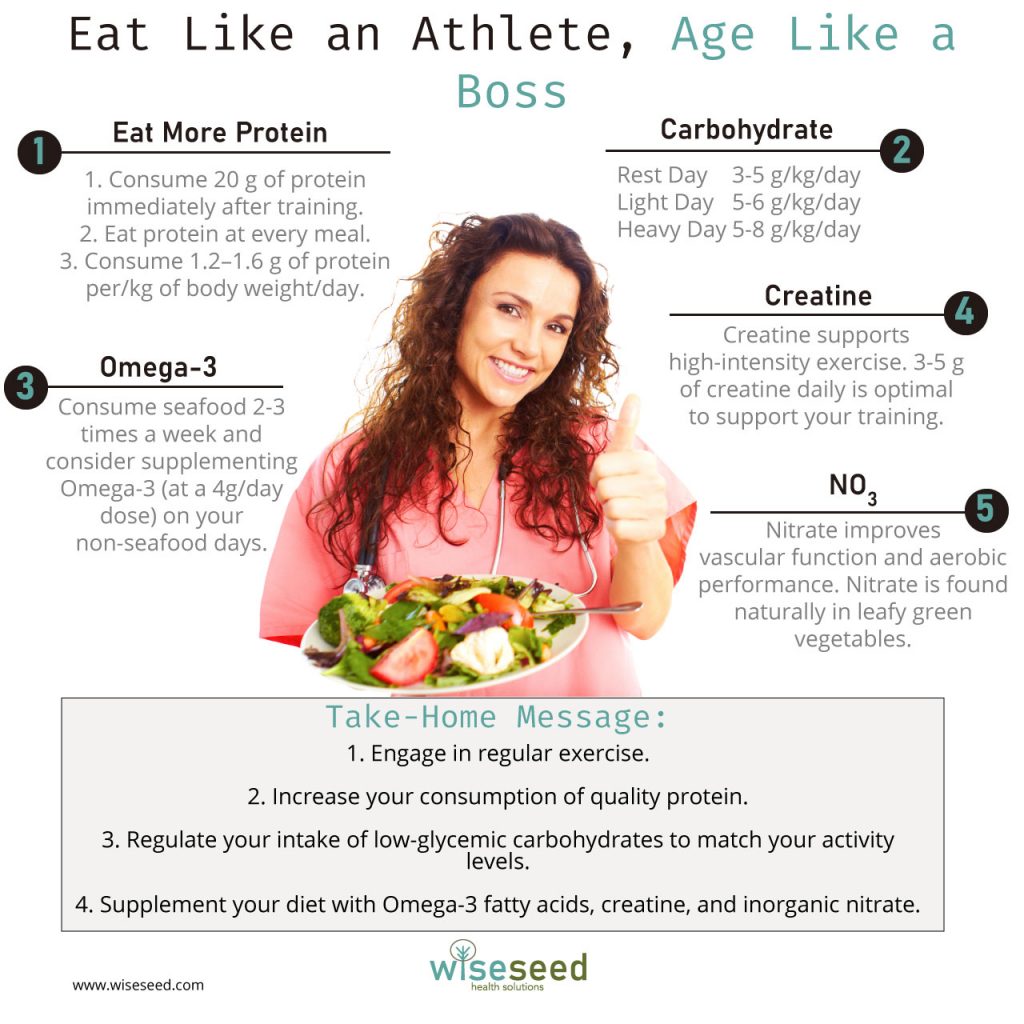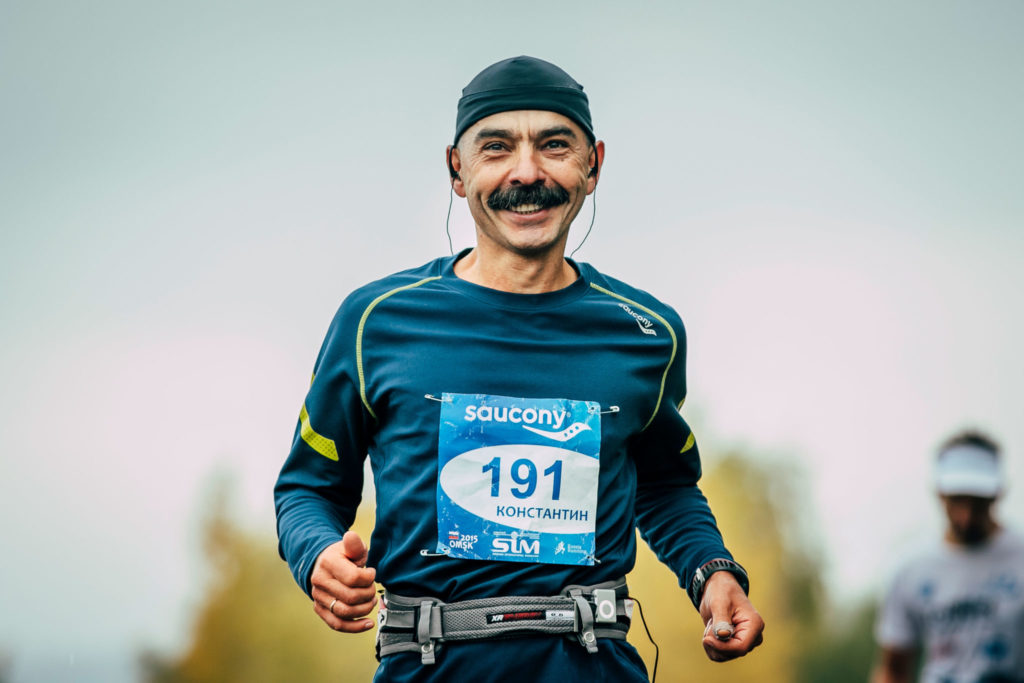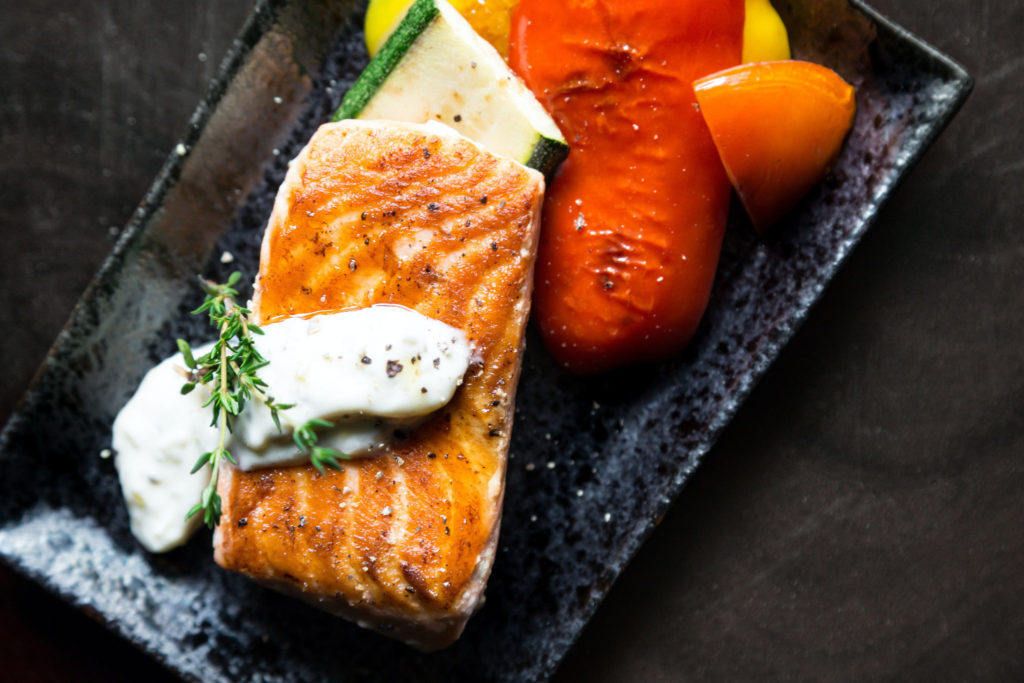Eat Like an Athlete, Age Like a Boss

‘Age is no barrier. It’s a limitation you put on your mind.’
Jackie Joyner-Kersee
It’s no secret that your physical performance declines with age. However, you might be alarmed at just how quickly you degrade after the age of fifty.
For example, after your 50th birthday, you can expect to lose around 1% of your muscle mass every year (1). Worse, your strength declines 3% per year, and you’ll lose a whopping 8% of your muscle power each year (1). Ouch!
Sadly, age-dependent loss of strength and muscle leaves many people physically disabled. Moreover, the physical decline caused by muscle loss contributes to losing independence, elevated disease risk, and the premature death of older adults.
The question is, do you want to spend your final decades of life disabled and fragile?
Hell no!
Fortunately, if you’re willing to put in the work, you can age like a boss.
Learn from Athletes!
Professional athletes are obsessed with improving their physical performance to win their chosen sport.
Naturally, a significant part of an athlete’s preparation is nutrition. After all, optimal nutrition supports an athlete’s adaptation to training and maximizes their performance on the field.
The good news is that the diets that support athletes can also help you maintain your physical performance you age (1).
Optimal Protein Consumption
Individually, both exercise (particularly resistance exercise) and protein consumption induce muscle growth. However, protein consumption combined with training produces the greatest improvements in muscle growth and strength (2). The synergy between exercise and protein is why athletes consume protein immediately after training (1).
Crucially, consuming protein also strengthens bones and connective tissue and is therefore critical for supporting long-term adaptation to exercise, including endurance exercise (3, 4).
Athletes consume 20 g of high-quality protein immediately after exercise to maximize their muscle growth and recovery. In addition, athletes eat well over the recommended daily protein intake throughout the day to support muscle growth and maximize their athletic performance (1).
Unfortunately, as you age, your muscles become less responsive to protein, a phenomenon known as anabolic resistance. Hence, adults over 60 require at least 40% more protein after exercise to experience the same increase in muscle growth enjoyed by the young (5).
For example, research has shown that an adult male over 60 years of age must consume 35 g of protein after exercise to maximize their muscle growth (5)!
Let’s face it, chugging down 35 g of protein post-workout and then munching on protein for the rest of the day to hit your 2g/kg/day protein requirement is very unappealing. Fortunately, it’s also unnecessary.
Instead, Oikawa and Colleagues recommend consuming 20 g of quality protein straight after working out (1). Furthermore, they advise eating 1.2–1.6 g of quality protein/kg of body weight/day, which is mercifully less than what a professional athlete consumes (1)!
Finally, they suggest eating some form of high-quality protein at every meal, as distributing your protein consumption throughout your day is optimal for increasing and maintaining lean muscle mass (1).
Thus, the recommendations for protein consumption for active older adults are:
- Consume 20 – 35 g of protein immediately after training.
- Spread out your protein consumption by eating protein at every meal throughout the day.
- Eat 1.2–1.6 g of quality protein per/kg of body weight/day.
Carbohydrate Periodization
According to many, carbohydrates are evil.
However, the reality is that carbohydrates fuel your athletic performance. But eating carbohydrates comes at a price: overeat carbohydrates, and you’ll gain unwanted fat. Moreover, if you consume excessive carbohydrates for an extended period, you significantly increase your risk of suffering metabolic and cardiovascular disease later in life.
Many athletes compete at a specific body weight; hence they must modify their carbohydrate intake to stay close to their competition weight. Therefore, athletes eat more carbohydrates on hard training days to fuel their training. In contrast, they scale back their carbohydrate intake on easy training days and rest days.
You should apply the same approach to your carbohydrate intake. Table One outlines a rough carbohydrate guide for the older adult. Stick to the lower end of the recommended intake if you seek to lose or maintain weight and move to the upper end if you are trying to increase your muscle mass.
Finally, your carbohydrate source matters! I recommend consuming low- and medium-glycemic carbohydrates that are digested slowly and don’t cause a spike in your blood sugar.
One great source of low-glycemic carbohydrates are whole grains. Whole grains include the bran, germ, and endosperm of the seed, the most nutrient-dense parts. In addition, whole grains (unlike refined grains) are rich in B vitamins, contain vitamin E, and are an excellent fiber source.
Another fantastic option is sweet potato. Unlike white potatoes, sweet potatoes are medium-glycemic so that they don’t cause a spike in your blood sugar levels. In addition, sweet potatoes are an excellent source of fiber, beta carotene, vitamin C, and potassium.
| Daily Physical Level | Exercise Duration (minutes) | Target carbohydrate intake g/kg/day |
| Rest Day | 0 | 3-5 |
| Light Day | 20-30 | 5-6 |
| Heavy Day | 60 + | 5-8 |
Omega-3 Fatty Acids
Athletes use Omega-3 supplements to reduce inflammation, support their immune system, speed recovery, and prevent infection (1). In addition, it’s thought that omega-3 supplementation increases the anabolic effect of protein consumption on muscle growth (1).
However, Omega-3 supplementation isn’t only for athletes. Supplementing with Omega-3 also helps older adults increase lean muscle mass. For example, long-term supplementation with Omega-3 fatty acids improved the muscle mass and strength of adults aged 60-80 years old (6).
Intriguingly, older women appear to benefit more from Omega-3 supplementation than men, with four months of Omega-3 supplementation combined with resistance training improving the lean muscle mass and strength of older women (7).
Most Omega-3 supplementation studies suggest consuming 4 g/day of Omega-3 (1). However, eating seafood 2-3 times a week not only supplies you with Omega-3 and protein, but studies show that seafood consumption reduces age-related cognitive decline (8). Seafood rich in Omega-3 includes fish, oysters, prawns, squid, and calamari, so plenty of tasty options are available.
Thus, the current recommendation is to consume seafood 2-3 times a week and consider supplementing Omega-3 (at a 4g/day dose) on your non-seafood days (1, 8).
Creatine
Creatine is one of the most popular sports supplements taken by athletes. Why? Because supplementing with creatine is a safe way to improve your capacity to perform high-intensity exercises (for example, during resistance training) (1, 9). Over time, training at higher intensities leads to significant improvements in both muscle mass and strength (1).
Supplementing with creatine may be particularly beneficial for older adults for several reasons.
First, older adults are at risk of having a creatine deficit. For example, older adults with reduced muscle mass often have reduced creatine levels in their muscles (10).
Second, creatine supplementation augments the effects of resistance training (11, 12) by increasing your ability to train at higher intensities (13).
Finally, there is emerging evidence that creatine supplementation increases bone density (when combined with resistance training) and improves mood and cognition (14, 15).
Thus, creatine supplementation offers several benefits for older adults. The current consensus is that supplementing up to 3-5 g of creatine daily (or at least on the days you exercise) is optimal to support your training (1, 9).
Inorganic Nitrate
Finally, athletes supplement with dietary sources of inorganic nitrate (NO3), such as beetroot juice, because inorganic nitrate improves their aerobic performance (1). Fortunately, the performance-enhancing effect of inorganic nitrate is most pronounced in moderately trained and recreational athletes (1). Thus, regular folk are going to get the most out of nitrate supplementation.
Significantly, because nitrate supplementation improves vascular function, it has health benefits above and beyond improving athletic performance. For example, NO3 supplementation helps lower blood pressure in older adults (1).
Moreover, inorganic nitrate is found naturally in leafy green vegetables, including spinach, lettuce, fennel, rocket, radishes, Chinese cabbage, and parsley (16). As we’ve discussed, eating leafy green vegetables is essential for preserving your mind as you age. Moreover, leafy greens provide essential vitamins, minerals, and fiber. A diet rich in leafy green vegetables also supports a healthy gut, with additional health benefits for older adults.
Thus, increasing your intake of leafy greens is an excellent strategy for increasing your intake of inorganic nitrogen!
Take-Home Message
1. Engage in regular exercise.
2. Increase your intake of quality protein.
3. Regulate your intake of low-glycaemic carbohydrates to match your activity levels.
4. Supplement your diet with Omega-3 fatty acids, creatine, and inorganic nitrate.

Acknowledgements
Images created by matthewennisphotography and Rasulovs
References and Further Reading
1. S. Y. Oikawa, T. D. Brisbois, L. J. C. van Loon, I. Rollo, Eat like an athlete: insights of sports nutrition science to support active aging in healthy older adults. Geroscience 43, 2485-2495 (2021).
2. G. Biolo, K. D. Tipton, S. Klein, R. R. Wolfe, An abundant supply of amino acids enhances the metabolic effect of exercise on muscle protein. Am J Physiol 273, E122-129 (1997).
3. P. Knuiman, L. J. C. van Loon, J. Wouters, M. Hopman, M. Mensink, Protein supplementation elicits greater gains in maximal oxygen uptake capacity and stimulates lean mass accretion during prolonged endurance training: a double-blind randomized controlled trial. Am J Clin Nutr 110, 508-518 (2019).
4. S. M. Phillips, Dietary protein requirements and adaptive advantages in athletes. Br J Nutr 108 Suppl 2, S158-167 (2012).
5. D. R. Moore et al., Protein ingestion to stimulate myofibrillar protein synthesis requires greater relative protein intakes in healthy older versus younger men. J Gerontol A Biol Sci Med Sci 70, 57-62 (2015).
6. G. I. Smith et al., Fish oil-derived n-3 PUFA therapy increases muscle mass and function in healthy older adults. Am J Clin Nutr 102, 115-122 (2015).
7. M. Da Boit et al., Sex differences in the effect of fish-oil supplementation on the adaptive response to resistance exercise training in older people: a randomized controlled trial. Am J Clin Nutr 105, 151-158 (2017).
8. M. C. Morris et al., MIND diet slows cognitive decline with aging. Alzheimers Dement 11, 1015-1022 (2015).
9. J. Antonio et al., Common questions and misconceptions about creatine supplementation: what does the scientific evidence really show? J Int Soc Sports Nutr 18, 13 (2021).
10. J. M. Hinkley et al., Older adults with sarcopenia have distinct skeletal muscle phosphodiester, phosphocreatine, and phospholipid profiles. Aging Cell 19, e13135 (2020).
11. M. C. Devries, S. M. Phillips, Creatine supplementation during resistance training in older adults-a meta-analysis. Med Sci Sports Exerc 46, 1194-1203 (2014).
12. A. F. Aguiar et al., Long-term creatine supplementation improves muscular performance during resistance training in older women. Eur J Appl Physiol 113, 987-996 (2013).
13. A. Casey, D. Constantin-Teodosiu, S. Howell, E. Hultman, P. L. Greenhaff, Creatine ingestion favorably affects performance and muscle metabolism during maximal exercise in humans. Am J Physiol 271, E31-37 (1996).
14. A. Stares, M. Bains, The Additive Effects of Creatine Supplementation and Exercise Training in an Aging Population: A Systematic Review of Randomized Controlled Trials. J Geriatr Phys Ther 43, 99-112 (2020).
15. A. E. Smith-Ryan, H. E. Cabre, J. M. Eckerson, D. G. Candow, Creatine Supplementation in Women’s Health: A Lifespan Perspective. Nutrients 13, (2021).
16. B. McNally, J. L. Griffin, L. D. Roberts, Dietary inorganic nitrate: From villain to hero in metabolic disease? Mol Nutr Food Res 60, 67-78 (2016).
Disclaimer
The material displayed on this website is provided without any guarantees, conditions or warranties as to its accuracy.
Information written and expressed on this website is for education purposes and interest only. It is not intended to replace advice from your medical or healthcare professional.
You are encouraged to make your own health care choices based on your own research and in conjunction with your qualified practitioner.
The information provided on this website is not intended to provide a diagnosis, treatment or cure for any diseases. You should seek medical attention before undertaking any diet, exercise, other health program or other procedure described on this website.
To the fullest extent permitted by law we hereby expressly exclude all warranties and other terms which might otherwise be implied by statute, common law or the law of equity and must not be liable for any damages whatsoever, including but without limitation to any direct, indirect, special, consequential, punitive or incidental damages, or damages for loss of use, profits, data or other intangibles, damage to goodwill or reputation, injury or death, or the cost of procurement of substitute goods and services, arising out of or related to the use, inability to use, performance or failures of this website or any linked sites and any materials or information posted on those sites, irrespective of whether such damages were foreseeable or arise in contract, tort, equity, restitution, by statute, at common law or otherwise.

Ten Minutes is All You Need
Research has shown that ten minutes of moderate-to-vigorous exercise performed each day is enough to significantly reduce your risk of early death.

Training for Longevity
Endurance training protects you from cardiovascular disease, whereas power training protects you from cancer. Therefore, if you want to live a long time, you should include both endurance and power training into your exercise routine.




